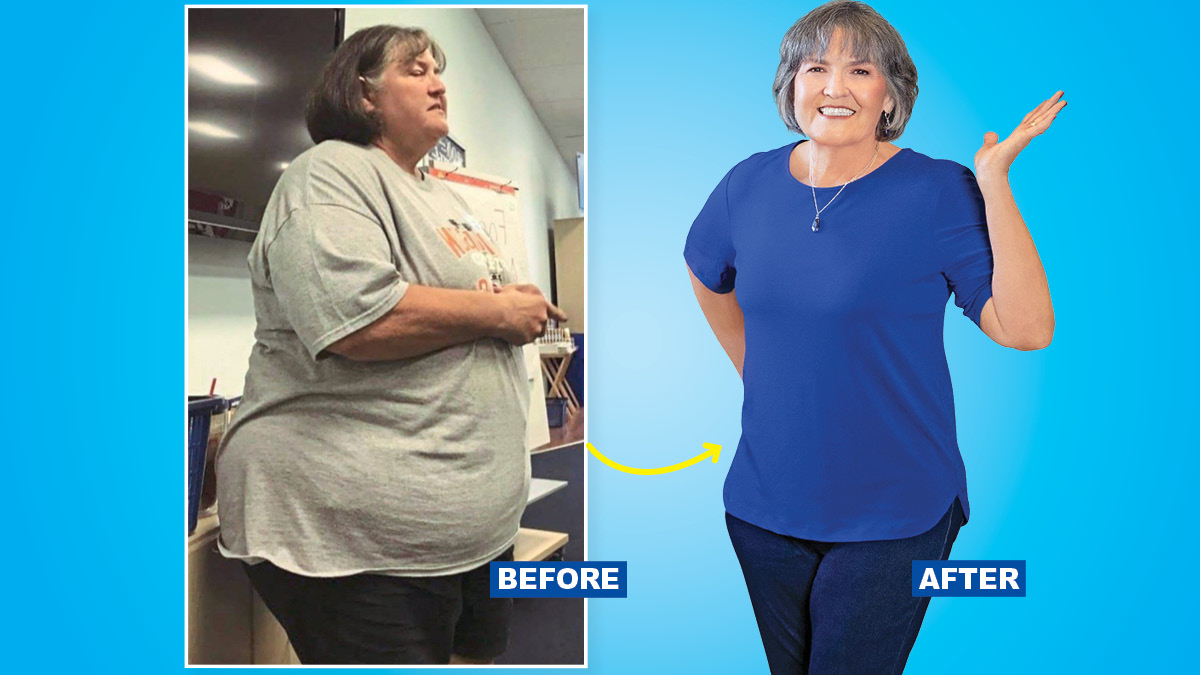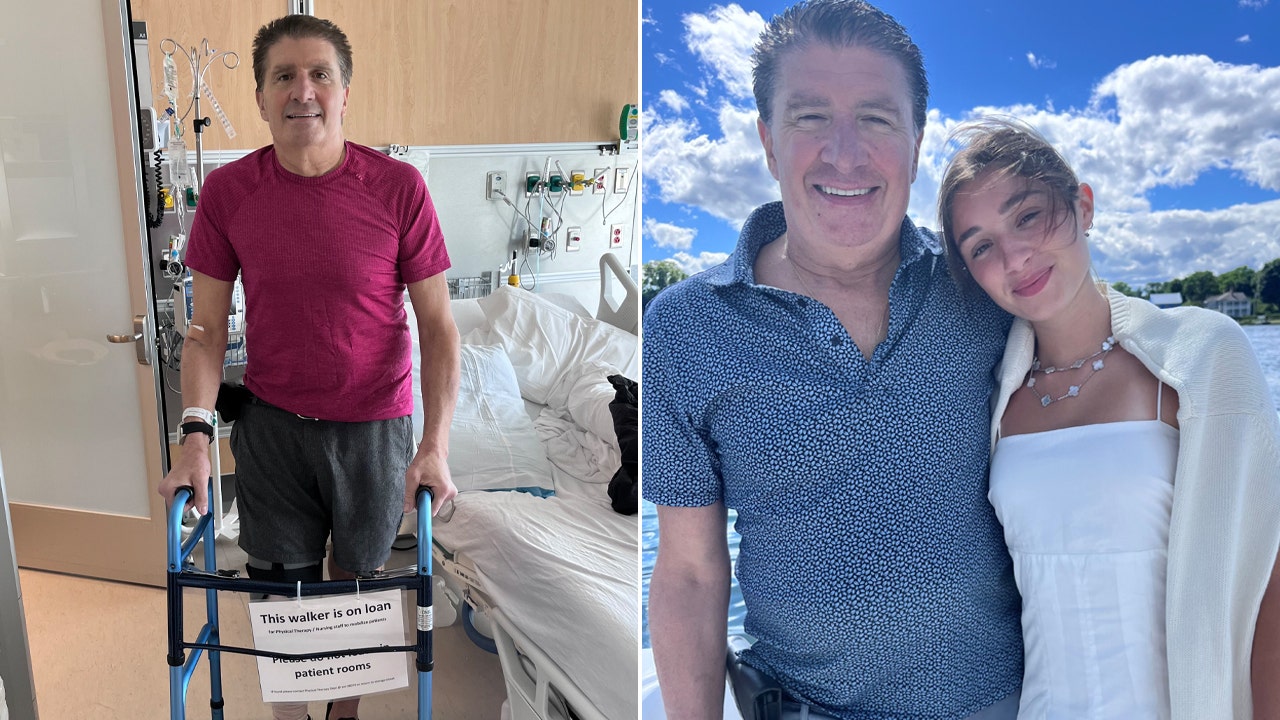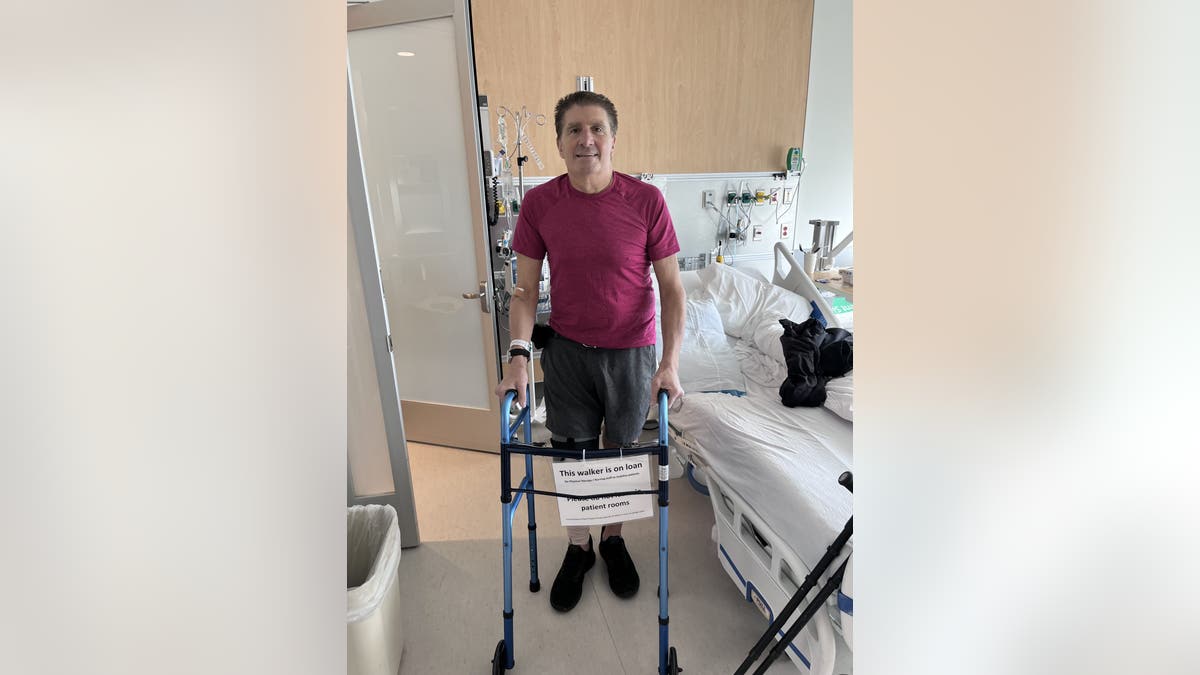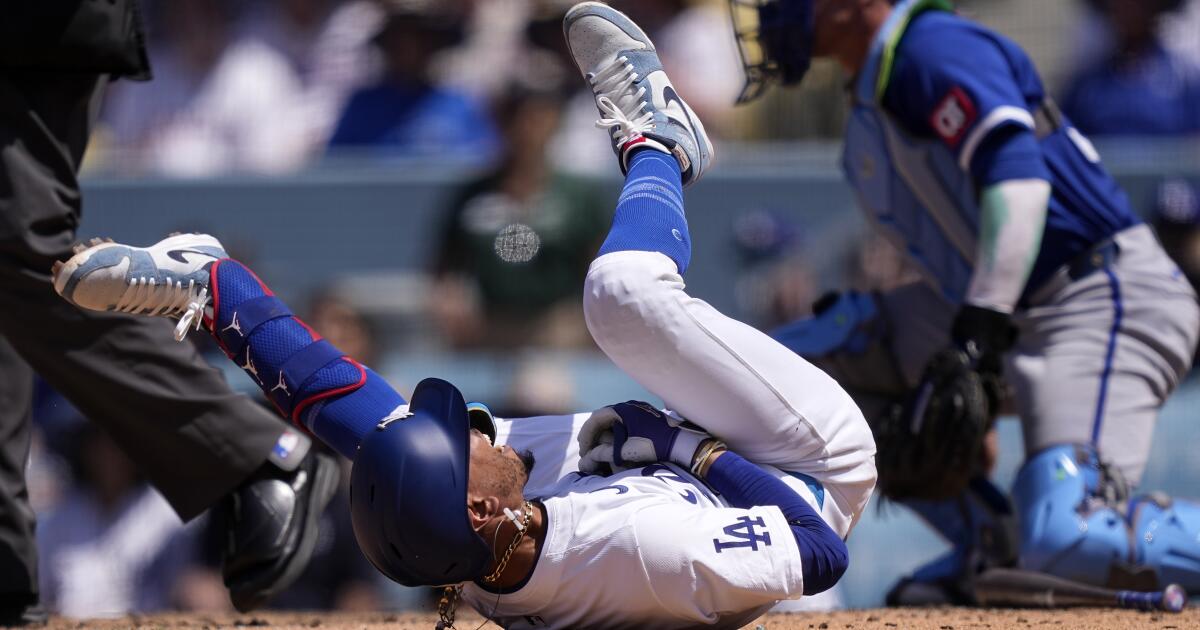Health
She Lost 207 lbs at Age 64 by ‘Reverse Dieting

One of the most frustrating parts of any health journey is when you hit a weight-loss plateau, and the scale won’t budge no matter how much you cut calories or get out and exercise. Researchers and dieters alike have wondered if eating more can help break through a weight loss plateau that was caused by eating less. Over the last few years, scientists have studied this ‘eat less and then eat more’ approach and many folks have experimented with it themselves.
What have they discovered? It turns out that rigid dieting pushes the body into a rut, explains Harvard-educated physician Ian K. Smith, M.D., former host of the syndicated television show The Doctors and author of the The Met Flex Diet. “The body’s number one goal is to be efficient, so it learns how to adjust to every scenario you throw at it,” he says. Knowing exactly how much energy it needs to perform its daily functions, the body burns just enough calories to keep it going and stores the rest as fat for a possible emergency. The thinking is that if you have some days where you eat a lot, you essentially trick the body into feeling secure enough to keep burning calories at a high rate.
What’s emerged from Dr. Smith’s investigations as well as from a growing body of research into ‘carb cycling’ is a new way of eating dubbed ‘reverse dieting.’ The thinking here is that by eating a little one day and a lot the next, you essentially fool your metabolism into burning faster every day. This approach to food has doctors excited thanks to research that shows reverse dieting can help accelerate fat burn. And it makes people who want to lose weight happy because who doesn’t want to have a few mandated cheat days?
To explore how reverse dieting works and the kinds of benefits it can deliver, we turned to Paula Briner, who lost a startling amount of weight—207 lbs to be exact—at age 64. Read on for her story and learn how reverse dieting may help you reach you happy weight.
How Paula discovered reverse dieting
After carrying extra pounds on her petite frame for years, Indiana grandmother Paula Briner started to have constant knee and foot trouble. “My knee was replaced. My arch fell, and I had to have it rebuilt with five screws,” she recalls. Doctors warned she might lose her foot. Terrified, she turned to food for comfort and her weight crept up and up. At 351 pounds and on medications for arthritis, high blood pressure, pain and more, “my husband had to tie my shoes because bending over would wear me out,” she remembers. “I didn’t want to live the rest of my life that way.”
Then few weeks after her 62nd birthday, Paula decided to give Weight Watchers another try. She’d been successful in the past, but there was always something that caused the program to stop working. This time, she walked into her first meeting with a goal of losing just 10 pounds, figuring that was manageable and should help with her pain.
Paula learned foods were still assigned a point value based on their calories and nutrients; the program would allow her over 40 points a day. Veggies had always been freebies; now fruit, corn and lean protein also had zero points and could be eaten without tracking. Her first week, she exceeded her goal and lost 11 pounds. “It was so exciting to see the scale go down that fast,” she says. Before she knew it, she was in the 200s. But that’s when things started to slow down, and it’s also when she discovered reverse dieting.
What is reverse dieting?
Like keto cycling, reverse dieting involves shifting between eating low-calorie on some days and high-calorie on others. While there are no official rules on how to use reverse dieting, Paula knew she ate so many freebie foods that she often didn’t use all her weekly points. So instead of cutting back of calories, she decided to treat herself to some of her favorites and see if she could break through the plateau.
To start reverse dieting, Paula used all her extra points on pepperoni pizza or Mexican food. At her next weigh-in, Paula stepped on the scale—and it turned out she was losing again. She left her plateau in the dust and continued to alternate between days when she ate mostly zero-point foods and days when she splurged. (She only counted points, but her intake was roughly 1,200 calories some days and 2,400 on others.) Another trick: She stopped eating after dinner and didn’t eat until she feels hungry the next day, advice she got from the Fast, Feast, Repeat podcast.
“The huge meals didn’t shut down my weight loss. They boosted my metabolism and got me where I am today!” says Paula, down 207 pounds and maintaining for three years. Gone are her pain meds, antidepressants and cane. At 68, she takes long hikes and even went parasailing with her grandkids. “I’ve been given my life back!”
The science behind reverse dieting
Like Paula, many ‘reverse dieters’ flip between 1,200-calorie days and 2,400-calorie days. “It might not sound like enough to make a difference, but continuously switching up your calorie intake throws the body off-kilter in a way that stimulates extra fat burning,” shares Met Flex Diet author Dr. Ian Smith.
In fact, researchers reporting in The American Journal of Clinical Nutrition found that reverse dieting may double fat loss and boost overall health compared to eating low-calorie every single day. And a study published in the International Journal of Obesity found that alternating between high- and low-calorie days may trigger biochemical changes that slash risk of diabetes and boost belly-fat burn by up to 60%.
How reverse dieting can boost overall health
Higher-calorie days offer relief from feelings of deprivation, making low-cal (or low “point”) days sustainable. And turns out, low-cal days do for your cells what exercise does for your muscles — challenging them in a way that leads to healing and renewal. This alternation between eating a little and eating a lot “makes cells stronger,” says Johns Hopkins nutrition researcher Mark Mattson, Ph.D., author of The Intermittent Fasting Revolution.
Research shows stronger cells improve appetite, blood sugar, immunity and even help lower blood pressure significantly more than a typical diet. And reverse dieting feels easy. “If you’ve struggled on other plans, this strategy could change everything,” notes Dr. Smith, whose devotees report shedding up to 11 pounds a week.
How to make reverse dieting work for you
One simple option for reverse dieting is to eat about 1,200 calories a day for a few days in a row, then allow yourself a 2,400-calorie day. That’s it! Figuring out what to eat on splurge days is easy, so we’re sharing fun ideas for your low-cal days.
For more great recipes and tips, Paula loves the site ThePoundDropper.com. You can learn more about the exact program she used at WeightWatchers.com. Here are a few meal ideas to get you started:
- BREAKFAST Simply scramble eggs (78 calories each) and/or egg whites (17 calories each) with veggies in cooking spray. Enjoy with fruit.
- LUNCH Top 1 low-carb tortilla with 1/4 cup fat-free marinara, 1/4 fat-free or part-skim mozzarella and optional toppings like red onion, ham, pineapple and oregano. Bake at 425°F until melted and golden (about 85 calories total).
- SNACK Spread lean deli meat (30 calories each) with fat-free cream cheese (15 calories per Tbs.). Roll with veggies and/or pickle spears
- DINNER Warm reduced-fat turkey meatballs (such as Kroger brand, 27 calories each) in fat-free marinara. Serve over zucchini “noodles.”
A version of this article originally appeared in our print magazine, Woman’s World.
This content is not a substitute for professional medical advice or diagnosis. Always consult your physician before pursuing any treatment plan.
ARNICARE FOR PAIN AND BRUISES!
Powered by Arnica montana, Arnicare® is designed to treat muscle pain, swelling, and discoloration from bruising. The unscented gel cools on contact and absorbs quickly into your skin, leaving no sticky or greasy residue, and provides you with the relief you seek. Learn more at Arnicare.com.

Health
'Yellowstone' Dads: See Your Favorite Cowboys With Their Adorable Kids

Sign Up
Create a free account to access exclusive content, play games, solve puzzles, test your pop-culture knowledge and receive special offers.
Already have an account? Login
Forgot your password?
Get back to the Sign In
Use left and right arrow keys to navigate between menu items.
Use escape to exit the menu.
Health
Cancer nearly took his leg, but this father of 6 is walking again: ‘I shouldn’t be here’

For one New York father of six who overcame the odds, this Father’s Day will be sweeter than most.
Richard Monti, a real estate developer who lives on Long Island, recently faced certain amputation after a life-threatening infection — until a determined doctor saved his leg with a complex surgery.
When Monti was diagnosed with metastatic kidney cancer in 2018, he thought that would be his toughest battle.
MELANOMA PATIENTS REVEAL DRAMATIC STORIES FOR SKIN CANCER AWARENESS MONTH: ‘I THOUGHT I WAS CAREFUL’
But after having surgery last year to repair his fractured upper shin bone — which had been damaged by years of cancer and radiation therapy — Monti developed sepsis, which threatened both life and limb.
Richard Monti, a real estate developer on Long Island, recently faced certain amputation after a life-threatening infection. A determined doctor was able to save his leg with a complex surgery. (Richard Monti)
It is relatively common for cancer patients to experience these types of fractures, according to Dr. Nicola Fabbri, chief of the Division of Orthopedic Oncology at NYU Langone Orthopedics, who treated Monti.
“When cancer is metastatic and goes to the bone, fractures do occur — it’s actually the main complication,” Fabbri told Fox News Digital in an interview.
“Probably 50% of people who develop bone metastases develop fractures.”
EXPERIMENTAL CANCER TREATMENT GIVES NEW JERSEY MOM A CHANCE FOR A SECOND BABY: ‘I DECIDED TO GO FOR IT’
While he was intubated and in a coma for several weeks, Monti underwent six surgeries to clean out the infection and try to restore his bones.
“They told my wife she should get prepared,” he told Fox News Digital in an interview. “They didn’t expect me to make it.”
Monti did pull through — but when he woke up, doctors delivered even more devastating news.

Richard Monti, center, is pictured with his family, who helped him get through his long ordeal. “I’m really living a normal life now,” he said. (Richard Monti)
“I was given basically one option, and that was amputation,” Monti, now 64, said in an interview with Fox News Digital.
The news sent Monti, who thrives on working on his feet, into a “very, very dark place.”
He said, “At that point, I was probably at my lowest. When my body moves, my mind moves. Losing that leg — I thought that was the way my story would end.”
“I was given basically one option, and that was amputation.”
Monti sought a second opinion from Dr. Fabbri of NYU Langone Orthopedics, who was highly recommended.
“When I met him, I loved what he said — ‘We don’t just cut legs off,’” Monti recalled.
After many tests and scans, the doctor told Monti he was “going back to the drawing board,” a nod to Monti’s building background.
“My wife and I started crying and smiling,” Monti recalled.

Dr. Nicola Fabbri, chief of the Division of Orthopedic Oncology at NYU Langone Orthopedics, was determined to save Monti’s leg. (Dr. Nicola Fabbri)
The doctor said he was hoping that given time, Monti’s sepsis would resolve, and his soft tissue would recover enough for a successful reconstruction surgery.
Monti’s case was complicated. He was dealing with an unhealed fracture of the upper part of his tibia, tissue damage from the sepsis infection, and significant bone loss and weakness from the radiation treatment for his cancer.
YOUNG GIRL SURVIVES CANCER THANKS TO LITTLE SISTER’S LIFESAVING DONATION: ‘A PERFECT MATCH’
“The sepsis was probably linked to being immunocompromised due to his cancer treatment,” Fabbri told Fox News Digital.
‘Performed miracles’
After Monti had some time to heal, he was deemed ready for surgery.
After 15 months of being in a brace and on crutches, Monti underwent a limb-preserving surgery consisting of a complex knee and tibia reconstruction.
While placing a new knee implant, Fabbri was able to correct the severe deformity caused by the fracture.
During the 11-hour surgery, which took place on Oct. 17 of 2023, the doctor also removed damaged parts of the tibia and replaced them with metal implants.

“That doctor and his team did perform miracles in my eyes,” Monti said of the surgery that saved his leg. (Richard Monti)
Now, Monti is pain-free, back to work — and able to walk without a cane or crutches.
“That doctor and his team did perform miracles in my eyes,” he said.
Monti still takes a chemotherapy pill once a day, and his tumors are now “very small, less than a centimeter.”
“For me to still be here — it means God’s got work for me to do.”
Although Fabbri has performed similar surgeries in the past, he noted that the circumstances of Monti’s challenges were “extremely rare.”
“This was a particularly challenging situation,” he said. “I never thought he could come back at this level. It’s really remarkable where he is today.”

Monti was able to walk on the beach just a couple of months after his surgery. “He can walk as tolerated with no support or limited support,” his doctor said. (Richard Monti)
Although Monti can’t run, he has “no substantial limitations” in his daily activities, his doctor told Fox News Digital.
“He can walk as tolerated with no support or limited support,” Fabbri said. “He sent me a video of him walking on the beach. It’s fantastic.”
CLICK HERE TO SIGN UP FOR OUR HEALTH NEWSLETTER
Throughout Monti’s darkest days, he said he drew strength from the love for his family — including his wife, five daughters and one son — and his faith.
“For me to still be here — it means God’s got work for me to do,” he said. “So I’m going to continue to do that work, because I honestly shouldn’t be here.”

Largely inspired by her father’s health journey, one of Monti’s daughters, pictured, has decided to pursue a career in nursing. “I’m so proud of her,” the dad said. (Richard Monti)
Recently, Monti was able to attend his daughter’s high school graduation, visit the college she will attend in the fall and enjoy a walk on the beach.
“It used to be that every step I took reminded me of cancer,” he said. “Every step was so painful. But now I really don’t think about it.”
“I’m living a normal life now.”
Largely inspired by her father’s health journey, one of Monti’s daughters has decided to pursue a career in nursing.
“Not everybody is so resilient.”
“I asked her why she was so determined to be a nurse,” Monti said. “She said, ‘Sitting there watching you all those months, I learned I had a lot to offer.’ I’m so proud of her.”
Fabbri credits Monti’s determination and positive outlook as being inextricably linked to his successful outcome.
For more Health articles, visit www.foxnews/health
“Not becoming discouraged and still willing to go ahead — it takes a lot of guts and determination,” he said.
“It takes a lot of strength to believe in yourself and your physician. Not everybody is so resilient.”
Health
Paleo and Atkins Diets: Low-Carb for Different Reasons | Woman's World

Sign Up
Create a free account to access exclusive content, play games, solve puzzles, test your pop-culture knowledge and receive special offers.
Already have an account? Login
Forgot your password?
Get back to the Sign In
Use left and right arrow keys to navigate between menu items.
Use escape to exit the menu.
-

 Politics1 week ago
Politics1 week agoNewson, Dem leaders try to negotiate Prop 47 reform off California ballots, as GOP wants to let voters decide
-

 World1 week ago
World1 week agoDozens killed near Sudan’s capital as UN warns of soaring displacement
-

 World1 week ago
World1 week agoVideo: U.S. Official Responds to Israeli Strike on a U.N. School in Gaza
-

 World1 week ago
World1 week ago‘Bloody policies’: Bodies of 11 refugees and migrants recovered off Libya
-

 Politics1 week ago
Politics1 week agoEmbattled Biden border order loaded with loopholes 'to drive a truck through': critics
-

 Politics1 week ago
Politics1 week agoGun group vows to 'defend' Trump's concealed carry license after conviction
-

 Politics7 days ago
Politics7 days agoShould Trump have confidence in his lawyers? Legal experts weigh in
-

 News1 week ago
News1 week agoWould President Biden’s asylum restrictions work? It’s a short-term fix, analysts say















